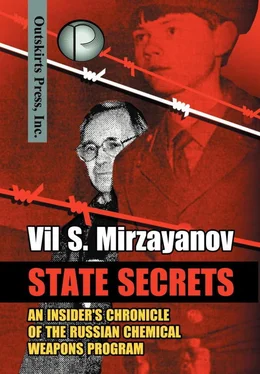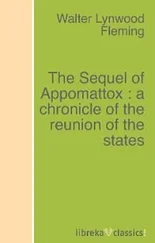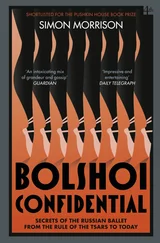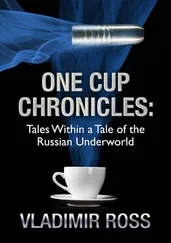Almost every future chief had to come to his position through membership in the Party Committee, at whatever the cost might be. For this reason, the struggle for a spot on the Party Committee was surprisingly tough at our Post Office Box. It was not enough for a striving would-be director to place the people he needed there. Other department chairmen, secretly dreaming of pushing upward to even higher positions, pressed forward their own people in turn. You could count on your fingers the science-chiefs who did not participate in this loathsome campaign. Evidently, success depended on how up to date you were on all the behind-the-scenes intrigues relating to new appointments and the allocation of bonuses. Your success also depended on your ability to keep track of your rivals, to get deeply involved in the personal affairs of your victims and to make short work of them without pity, all in the name of the party.
There were several who especially distinguished themselves in this respect, bosses who played so well with other people on this disgusting Communist balalaika. They were Professor Vladimir Zoryan – who became Chairman of the Department of Medical and Biological Research (“MB” Department), his protégé Professor Grigory A. Patrushev- who later became the director of the institute, Vsevolod Dobrianski – the head of the laboratory of the “MB” Department, Victor Shulga – the head of another laboratory in the same department, and Vladislav Sheluchenko – head of Department “D” (Degasification). There was also Evgeni Fokin who, thanks to his tainted academician father, became chief of the laboratory for synthesizing chemical agents. Finally, I would like to mention Mikhael M. Fedyachkin, chief of the laboratory in the Analytical Department, and Professor Mikhael A. Englin, head of the laboratory for synthesizing fluoroorganic compounds.
Each of these people possessed exceptional talent in demagoguery, though they were not particularly flourishing in their scientific affairs. The last of them, Englin, without any embarrassment, held the infra-red spectra of research compounds upside down several times, because he hadn’t taken the time to learn about them. Aside from his regular duties, he also served as chairman of the committee that examined and made decisions about the publication of scientific articles in the open press, especially those dedicated exclusively to peaceful problems. Although the decisions of this committee were not definitive and approval by the Central Directorate was also required, the final decision usually depended on this committee.
Under the leadership of Englin, this committee ruined many of my articles, which were dedicated purely to chromatographic problems. The reasoning of this professor was always primitive, and not subject to appeal. Once I brought an article entitled “New Chromatographic Methods for the Separation of Hydrocarbon Gases” to this committee for scrutiny. “An article about gases?” asked the scientist-Chekist. “Well, no. This kind of business won’t work, because you are disclosing the nature of the work of our enterprise. For instance, our laboratory is busy synthesizing gases.” Then he peremptorily shot down my article.
Three months later at the next meeting of Englin’s committee, when I brought a revised article with the title “New Chromatographic Methods for the Separation of Short-Chain Hydrocarbons” for consideration, the vigilant professor again rejected my work, saying this time: “Aha! This means a new method. Then you must take it through the patent application process and only after that come to me. Do you understand?” In truth, the limits of this veteran’s “creativity” were unknown, and it was useless to try to change his mind. He knew very well that he was holding on to his position only by his fervor. At one time Englin had also been “head chemist” on the problems of synthesizing chemical agents capable of breaking through gas mask filters.
Unhappily for Englin, difluoromethylamine was his only “invention”, and luckily it was incapable of breaking through the gas mask filters. It could only burn up instantly in the air. However, this was ample reason to award him with a doctoral degree and the title of professor.
Another person mentioned above, Vladislav Sheluchenko, did not go any further in the service of science than Englin. I frequently collided with him in our discussions of my GC methods of analysis of chemical agents. My arrival at Post Office Box 702 corresponded to a period in time when chromatography was beginning to come into its own as a method of analysis. This indisputably progressive method was already widely used in all industrialized countries and in many areas of science and industry, so I was astonished to find that they were only beginning to apply chromatography at GOSNIIOKhT.
Partially, this situation was due to the difficulties connected with the chromatographic instruments used in the area of defense. During the analyses of highly toxic compounds, the instruments themselves became increasingly dangerous, because probes of deadly compounds were injected and forced through them with inert gas from a tank connected to the gas chromatograph. Any breach of hermeticity, spilling of the probe, breakage of the micro-syringe dosing the probe, or another mishap could give the operator enormous trouble, even severe poisoning. For example, if we introduced a probe of 10 micro liters of Substance 33 into the instrument, and for any reason that probe made contact with someone, the consequences would be extraordinarily severe for him.
The construction of the lab bench and the chromatographic instruments was such that, there were absolutely no guarantees that an accident could not occur to poison people. However, thanks to the enthusiasm of the young scientists at this time, especially Igor A. Revelski and Yuri Novikov, I was able to find solutions to these problems and make progress on chromatographic methods for creating routine analyses of numerous samples.
Since I was the first person to come to the Post Office Box with a science degree granted for research in the field of chromatography, I wanted to develop methods for the detection of micro-concentrations of chemical agents in various media.
Before that, they had used traditional indicator methods for making judgments about the nature and concentrations various chemical agents, by examining the color and intensity of the dyed by-products of the reaction. There was (and still is) a large laboratory at GOSNIIOKhT for researching these methods. In those days Lev Brovkin was the head of this laboratory, and along with Sheluchenko, he blatantly wrestled to keep a monopoly in this important area. Whoever dared to propose an alternative method was treading on their turf and became their personal enemy. They struggled against him in every possible way.
Naturally, my boss warned me about this in advance, when I had proposed researching chromatographic methods for determining the presence of soman and sarin in the air and water.
Receiving the go ahead for this work, I finished the project along with my co-workers relatively quickly and wrote up a report, which had to be approved by the Deputy Director of Scientific Work, Shchekotikhin. He was a clever old hand at this kind of thing, and he decided to avoid the risk of getting drawn into a dispute with Brovkin and his protégé Konstantin A. Guskov, another deputy director in the science area. So, in keeping with the purest tradition of Soviet bureaucracy, he gave my report to Guskov for approval.
Along came the year 1967, and chromatographic methods were universally acknowledged as progressive. They were being widely adapted for solving many problems in industry and scientific research. In our Post Office Box, however, they had decided to arrange a kind of a trial for them, the goal of which was to reject the use of chromatography for all military chemical agents.
Читать дальше












